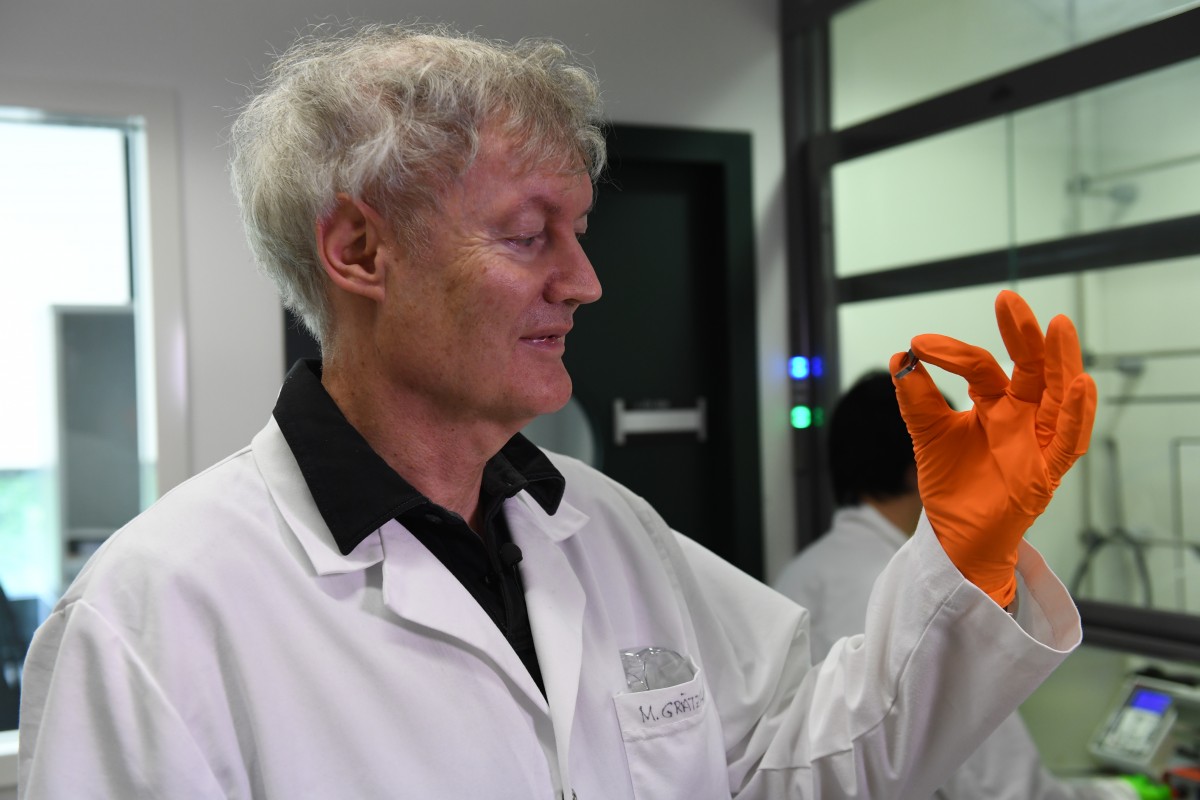
Michael Graetzel, in front of SwissTech Convention Center, the first large-scale convention hall to use EPFL's dye-sensitized solar cells (also known as Grätzel Cells). ©Christian Grund, 13photo.ch, ETH Board.
Solar cell pioneer speaks on alternative energy sources
In a world facing a looming energy crisis, the person with the title “Solar Cell Pioneer” is bound to attract a great deal of attention. Enter world-renowned electrochemist, Professor Michael Grätzel, a researcher who has dedicated his career to the discovery of a low-cost means of capturing solar energy. His upcoming lecture, entitled “Energy Beyond Oil” will review recent progress in the area of exploitation of solar energy converters based on molecular dyes or perovskite pigments as light harvesting materials.
The German-born Grätzel graduated from the Free University of Berlin in 1968, going on to earn his PhD in natural science in 1971 from the Technical University of Berlin. Since 1977, he has held the position of Professor at the Swiss Federal Institute of Technology in Lausanne, where he directs the Laboratory of Photonics and Interfaces. It was in 1988 that Grätzel, along with co-inventor Brian Regan, developed the world’s first solar cell based on the natural process of photosynthesis, now commonly referred to as a Grätzel cell.
Using special dyes that mimic the ability of chlorophyll in plants, the cell is able to capture light and turn it into electricity. Unlike conventional silicon-based solar cells, they are made of inexpensive materials, are flexible and can work in low light conditions. They can also be integrated into liquids and gels, allowing them to be tinted and installed on window panels. This unique application allows windows to let in light while simultaneously generating the energy required to cool or heat the building.
It’s exactly the kind of technology our world craves, since it is estimated that by 2050 there will be a 20-terawatt shortfall between global energy needs and production capacity. The long-standing practice of burning fossil fuels to meet energy demands is increasingly unsustainable, given the finite nature of these resources and their negative environmental impact. Alternatively, solar energy is a far more environmentally sustainable prospect. Since the earth receives 81,000 terawatts of energy from the sun, 5,000 times more than the total global demand, there is plenty for our needs. The trick has been to find an efficient and cost-effective way to harness that energy.


Grätzel’s ground-breaking discovery might not have happened, had he decided to follow his other passion: music. An accomplished pianist, he considered becoming a professional musician instead of pursuing research. Luckily for the world, Grätzel opted for what he felt was the “safer bet” of an academic career.
Unsurprisingly, his cutting-edge work with solar cells has earned him a great deal of attention in the scientific community. Grätzel has published over 1,000 articles and filed 50 patents, which accomplishments have made him one of the top ten most cited chemists on the planet. He has received a dizzying array of awards, citations, honorary degrees and doctorates, including the Albert Einstein World Award of Science in 2012 and the Millennium Technology Prize, which is awarded every two years to a pioneering technological innovator. In 2015, his work was considered for the Nobel Prize in Chemistry.
The University of Manitoba’s Faculty of Science is pleased to welcome Dr. Grätzel for what should be an enlightening examination of the current state of solar energy.
Who: Dr. Michael Grätzel, Swiss Federal Institute of Technology at Lausanne
Topic: “Energy Beyond Oil” Department of Chemistry, Robert H. Betts Lecture in Chemistry
When: Thursday, April 12, 2018 at 7:00 p.m.
Where: Robert Schultz Theatre, University of Manitoba, Fort Garry campus
All are welcome to attend, keeping in mind that rush seating will be in effect in the Robert Schultz Theatre within St. John’s College. Refreshments to follow.
For more information, please contact Ms Jennifer MacRae, Communications Officer, Faculty of Science, University of Manitoba at 204-474-8790 or via email at jennifer.macrae@umanitoba.ca.






